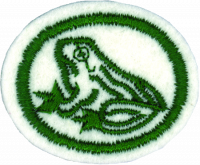Difference between revisions of "AY Honors/Amphibians/Answer Key/pt-br"
From Pathfinder Wiki
< AY Honors | AmphibiansAY Honors/Amphibians/Answer Key/pt-br
(Created page with "</noinclude> <!-- 6. Descrever ou esquematizar o ciclo de vida de um anuro. -->") |
(Updating to match new version of source page) |
||
| (One intermediate revision by one other user not shown) | |||
| Line 12: | Line 12: | ||
{{clear}} | {{clear}} | ||
| + | |||
| + | <div lang="en" dir="ltr" class="mw-content-ltr"> | ||
| + | ;Order Caecilian ''(also known as Gymnophiona)'': Latin for "blind ones", these are a group of limbless, vermiform (worm-shaped) or serpentine (snake-shaped) amphibians with small or sometimes nonexistent eyes. They mostly live hidden in soil or in streambeds, and this cryptic lifestyle renders caecilians among the least familiar amphibians. Caecilians feed on small subterranean creatures such as earthworms. The body is cylindrical and often darkly coloured, and the skull is bullet-shaped and strongly built. The skin is slimy and bears ringlike markings or grooves and may contain scales. | ||
| + | </div> | ||
<noinclude></noinclude> | <noinclude></noinclude> | ||
| Line 98: | Line 102: | ||
{{CloseReq}} <!-- 8 --> | {{CloseReq}} <!-- 8 --> | ||
{{ansreq|page={{#titleparts:{{PAGENAME}}|2|1}}|num=9}} | {{ansreq|page={{#titleparts:{{PAGENAME}}|2|1}}|num=9}} | ||
| − | <noinclude> | + | <noinclude></noinclude> |
| − | </noinclude> | + | <!-- 9. Qual parte do corpo é utilizada para amplificar o som que os anuros produzem? Tanto machos quanto fêmeas são capazes de coachar? Para que os anuros utilizam seus coachos? --> |
| − | <!-- 9. | ||
| − | |||
| − | |||
| − | |||
| − | |||
| − | |||
| − | |||
| − | |||
| − | |||
| − | |||
| − | |||
| − | |||
| − | |||
{{clear}} | {{clear}} | ||
| Line 119: | Line 110: | ||
{{CloseReq}} <!-- 9 --> | {{CloseReq}} <!-- 9 --> | ||
{{ansreq|page={{#titleparts:{{PAGENAME}}|2|1}}|num=10}} | {{ansreq|page={{#titleparts:{{PAGENAME}}|2|1}}|num=10}} | ||
| − | <noinclude> | + | <noinclude></noinclude> |
| − | </noinclude> | + | <!-- 10. Observar um anfíbio em seu habitat natural ou cativeiro por cerca de 15 minutos e escrever um relatório sobre o que observou. --> |
| − | <!-- 10. | ||
| − | |||
| − | |||
{{clear}} | {{clear}} | ||
| Line 130: | Line 118: | ||
{{CloseReq}} <!-- 10 --> | {{CloseReq}} <!-- 10 --> | ||
{{ansreq|page={{#titleparts:{{PAGENAME}}|2|1}}|num=11}} | {{ansreq|page={{#titleparts:{{PAGENAME}}|2|1}}|num=11}} | ||
| − | <noinclude> | + | <noinclude></noinclude> |
| − | </noinclude> | + | <!-- 11. Do que e como a maioria dos anuros se alimenta? --> |
| − | <!-- 11. Do | ||
| − | |||
{{clear}} | {{clear}} | ||
Latest revision as of 16:54, 26 February 2025
1
Quais as características dos anfíbios?
2
Dar o nome das 3 ordens pertencentes à classe Anphibia e citar as principais diferenças entre elas.
- Order Caecilian (also known as Gymnophiona)
- Latin for "blind ones", these are a group of limbless, vermiform (worm-shaped) or serpentine (snake-shaped) amphibians with small or sometimes nonexistent eyes. They mostly live hidden in soil or in streambeds, and this cryptic lifestyle renders caecilians among the least familiar amphibians. Caecilians feed on small subterranean creatures such as earthworms. The body is cylindrical and often darkly coloured, and the skull is bullet-shaped and strongly built. The skin is slimy and bears ringlike markings or grooves and may contain scales.
3
Popularmente, para se diferenciar entre anuros utilizam-se os nomes sapos, pererecas e rãs. Como podemos fazer para diferenciar entre estes 3 tipos de anuros? Use imagens.
4
Como os anfíbios se protegem?
5
Fazer uma coleção através de fotos ou imagens retiradas de livro ou internet de 10 diferentes espécies de anfíbios encontrados em seu estado ou país.
6
Descrever ou esquematizar o ciclo de vida de um anuro.
7
Explicar o valor econômico dos anfíbios.
8
Onde os sapos passam o inverno ou a estação seca?
9
Qual parte do corpo é utilizada para amplificar o som que os anuros produzem? Tanto machos quanto fêmeas são capazes de coachar? Para que os anuros utilizam seus coachos?
10
Observar um anfíbio em seu habitat natural ou cativeiro por cerca de 15 minutos e escrever um relatório sobre o que observou.
11
Do que e como a maioria dos anuros se alimenta?
11a
11b


